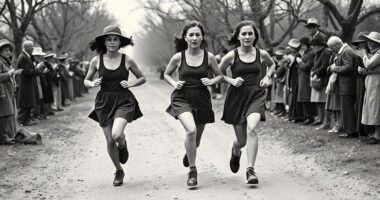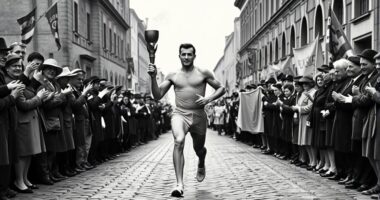Indoor board tracks wowed audiences in the early 20th century with their innovative wooden surfaces, daring drivers, and urban settings. These tracks showcased technological advances like painted surfaces and specialized lighting, making racing faster and more spectacular. However, safety risks, structural failures, and huge maintenance costs led to their decline by the 1930s. Despite their disappearance, their impact still influences modern motorsports. To discover what made this era so remarkable—and why it faded—you’ll find the story fascinating.
Key Takeaways
- Indoor board tracks emerged in the early 20th century, utilizing painted surfaces and advanced lighting to enhance racing speed and safety.
- Technological innovations like hydrocolloid grip and reinforced wooden structures revolutionized racing performance.
- The popularity of indoor tracks declined due to safety hazards, high maintenance costs, and structural failures.
- Notable drivers and dramatic races cemented the tracks’ cultural significance and legendary status.
- Their legacy influenced modern motorsports design, safety standards, and entertainment-focused racing.
Origins of Indoor Board Tracks and Their Early Development

Indoor board tracks emerged in the early 20th century as an innovative solution to the challenges of outdoor racing. You notice that the tracks were constructed with painted surfaces, which allowed for smoother, faster racing conditions and easier maintenance. These painted surfaces helped define the racing boundaries clearly, making races more predictable and safer. To keep the races lively and visible, indoor lighting played a vital role, illuminating the entire circuit evenly and reducing shadows that could cause accidents. As a result, fans could watch the action more clearly, and drivers gained better visibility at high speeds. The use of hydrocolloid technology in some track surfaces further enhanced safety by providing better grip and reducing skidding. These early developments laid the foundation for indoor racing’s popularity, showcasing how innovations in track surface and lighting technology improved safety and excitement.
Architectural Design and Engineering of Wooden Circuits

The construction of wooden circuits required careful attention to architectural design and engineering principles to guarantee safety, durability, and performance. You had to create strong wooden structures capable of supporting high-speed racing and heavy loads, often under intense stress. Engineers faced significant challenges, such as ensuring the track’s stability while maintaining smoothness for fast laps. The curves and banking had to be precisely engineered to prevent wobbling or collapse, especially since these circuits used lightweight, often warped, wood. You also needed to contemplate moisture and temperature effects that could weaken the structures over time. Balancing safety with performance demanded innovative solutions, like reinforced joints and carefully selected timber, to withstand the engineering challenges inherent in designing these intricate wooden circuits. Additionally, understanding the regional regulations and operational hours was crucial for scheduling construction phases and maintenance to minimize disruptions. Proper materials selection was essential to enhance the longevity of the tracks, especially considering environmental factors that could accelerate deterioration. Incorporating advanced engineering techniques could further improve the resilience and safety of these historic tracks.
The Spectacle of Racing: Drivers and Notable Events

You’ll see how legendary drivers pushed the limits with their incredible feats on indoor tracks. Memorable race events kept spectators on the edge of their seats, showcasing daring maneuvers and fierce competition. These moments defined the excitement and drama that made indoor racing unforgettable.
Legendary Drivers’ Feats
Among the many drivers who competed on indoor board tracks, a few stand out for their extraordinary feats that have become racing legends. These drivers pushed the limits of automotive advancements, mastering the treacherous turns and high speeds that defined indoor racing. Their daring maneuvers often defied expectations, leaving spectators in awe. As urban development expanded, indoor tracks emerged in city centers, challenging drivers to adapt quickly to changing environments and tighter spaces. One legend, Ralph DePalma, was renowned for his precise control and fearless acceleration, setting speed records that stood for years. These feats weren’t just about raw speed; they showcased skill, innovation, and courage, cementing these drivers’ places in racing history and highlighting the extraordinary human achievement behind every lap. Additionally, the drivers’ ability to maintain a growth mindset in such dangerous conditions was essential for their continued success and resilience against setbacks.
Furthermore, their mental resilience was crucial in overcoming the psychological challenges posed by the high-risk environment of indoor tracks.
Memorable Race Events
Indoor board races are remembered not only for their fierce competition but also for the unforgettable moments that left spectators on the edge of their seats. You recall races where daring drivers executed daring passes, showcasing masterful racing strategy. One iconic event involved a last-minute overtaking move that became vintage memorabilia among racing fans. These races featured dramatic crashes and close finishes that defined an era. The spectacle often centered around standout drivers whose skill and nerve created legendary stories. The table below highlights some notable moments:
| Event | Key Driver(s) |
|---|---|
| Near-miss crash at Madison | Jim McGraw |
| Record-breaking lap | Frank Schneider |
| Last-lap pass for victory | Eddie Rickenbacker |
| Unexpected upset | Johnny Williams |
Memorable race events like these cemented indoor board racing’s place in history, illustrating how the spectacle of racing continues to captivate fans and preserve the sport’s legacy. This era’s competitive spirit remains a testament to the daring and skill of the drivers involved, with racing strategy playing a crucial role in determining winners. Additionally, the professional services offered during this period helped shape the development and promotion of these thrilling events.
Cultural Impact and Popularity During the Early 20th Century
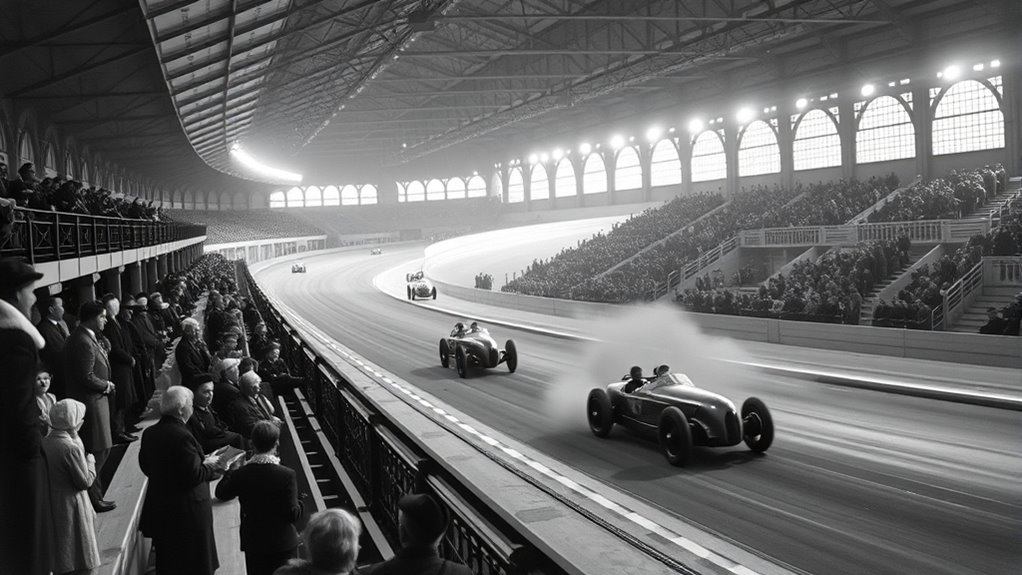
During the early 20th century, indoor board tracks captured public imagination as innovative racing venues that thrilled spectators. Their popularity grew quickly, turning races into major cultural events that drew crowds from all walks of life. This surge in engagement made indoor tracks a true phenomenon, shaping the era’s entertainment landscape.
Spectacle of Innovation
The rise of indoor board tracks captivated the public with their daring design and high-speed thrills, marking a bold chapter in sports entertainment. These venues showcased technological innovations that revolutionized racing, such as reinforced wooden surfaces and specialized lighting systems, allowing races to occur year-round. As urban development surged, indoor tracks became focal points within cities, blending entertainment with modern architecture. The spectacle of innovation drew crowds enthusiastic to witness speed and daring feats in enclosed spaces, creating a sense of excitement unlike any other. These tracks symbolized progress, combining engineering ingenuity with the desire for spectacle. Their popularity reflected a cultural appetite for cutting-edge entertainment, making indoor board tracks a remarkable intersection of technological progress and urban growth in early 20th-century America.
Cultural Phenomenon Rise
As spectators flocked to these high-speed spectacles, indoor board tracks transformed racing from a mere sport into a cultural phenomenon that captured the imagination of the early 20th-century public. Cars became symbols of modernity, emphasizing automotive aesthetics that blended speed with style. These venues influenced urban planning, shaping city skylines and entertainment districts. The excitement extended beyond racing, inspiring fashion, music, and local economies. Below is a comparison of key cultural impacts:
| Aspect | Effect |
|---|---|
| Automotive aesthetics | Elevated car design to art form |
| Urban planning | Integrated tracks into cityscapes |
| Popular culture | Sparked music and fashion trends |
| Economic influence | Boosted local businesses |
Indoor board tracks weren’t just racing venues—they became symbols of progress and modern identity during that era.
Spectator Engagement Surge
Indoor board tracks captivated audiences like few other entertainment venues of the early 20th century, fueling a surge in spectator engagement that transcended mere sport. Fans flocked to these events, enthusiastic for the adrenaline rush and audience thrill they delivered. The high-speed races, daring stunts, and close finishes created a charged atmosphere that kept viewers on the edge of their seats. Spectator engagement surged as crowds cheered wildly, captivated by the danger and skill displayed by the drivers. These races became social spectacles, drawing communities together and fueling a sense of excitement and innovation. The thrill of watching cars race on the treacherous, elevated tracks made indoor board tracks a cultural phenomenon, leaving a lasting impact on sports entertainment during that era.
Challenges and Safety Concerns Leading to Decline
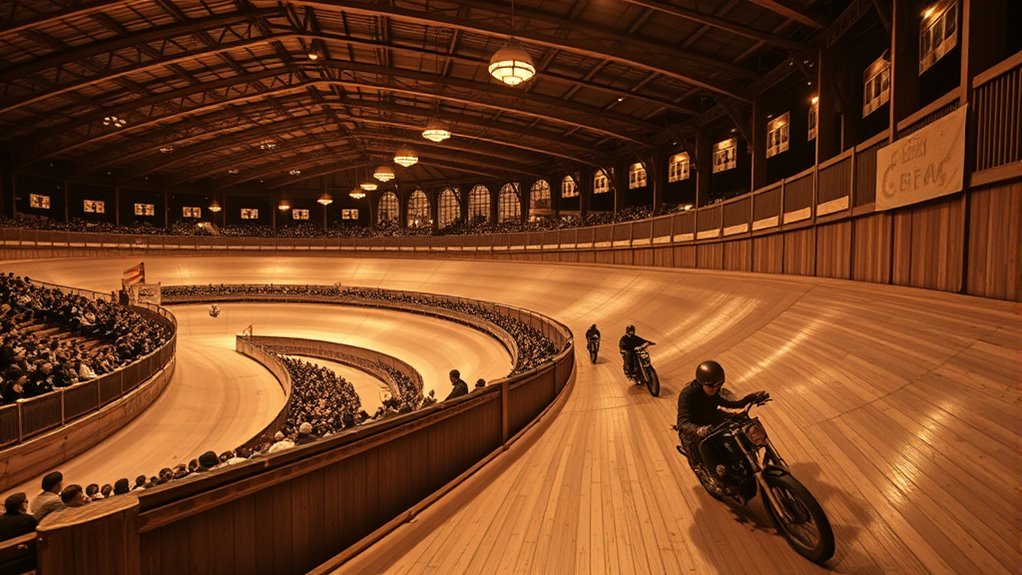
Despite their popularity, indoor board tracks faced increasing safety challenges that eventually contributed to their decline. The wooden structures often developed safety hazards over time, making them risky for both riders and spectators. Structural failures became more common as the tracks aged, sometimes leading to catastrophic collapses during races. These issues raised serious concerns about rider safety, and accidents on these tracks resulted in injuries and even fatalities. Maintenance proved difficult and costly, as the intricate design and materials required constant inspection and repairs. As safety hazards mounted and accidents drew attention, public confidence waned. The inherent risks and structural vulnerabilities ultimately made indoor board tracks too dangerous to sustain, forcing the industry to seek safer alternatives and contributing to their decline.
Economic Factors and Maintenance Costs

The high costs associated with building and maintaining indoor board tracks quickly became a significant obstacle to their continued operation. A thorough cost analysis revealed that expenses for materials, labor, and upkeep were substantial, often exceeding revenue from races. Maintenance costs, especially for the wooden surfaces, were ongoing and expensive, requiring constant repairs to ensure safety and performance. Additionally, sponsorship challenges made it difficult to secure enough financial support. Without strong sponsorship backing, covers for costs fell short, forcing track owners to either raise ticket prices or shut down altogether. These economic pressures combined to limit the viability of indoor board tracks, contributing to their decline after their brief period of popularity. Ultimately, financial sustainability proved too difficult to maintain long-term.
Legacy and Influence on Modern Motorsports
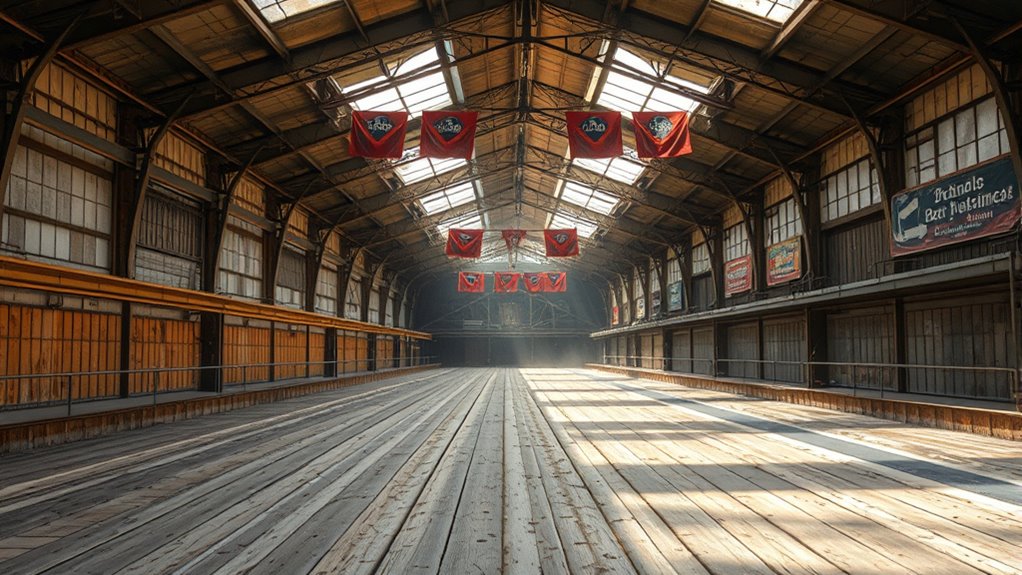
While indoor board tracks had a relatively brief existence, their influence on modern motorsports remains significant. They shaped automotive aesthetics, inspiring sleek, innovative designs that emphasize speed and style. Their unique racing regulations pushed drivers to develop new skills, contributing to the sport’s evolution.
Indoor board tracks influenced modern motorsports through innovative design and skill development.
Here are three key legacies:
- Design Inspiration: Modern race tracks incorporate features from indoor board tracks, emphasizing tight turns and rapid acceleration.
- Safety Standards: Lessons learned from their hazards led to stricter safety regulations, protecting drivers today.
- Spectator Engagement: The excitement and close racing of indoor tracks influenced modern entertainment-focused motorsports.
Your appreciation for racing’s history deepens as you see how these tracks helped shape today’s high-speed, visually enthralling motorsports scene.
The End of an Era: Why Indoor Board Tracks Disappeared

Indoor board tracks vanished from the racing scene because their inherent hazards and operational challenges outweighed their entertainment value. The indoor ambiance, once exciting, became overshadowed by safety concerns as wooden surfaces proved unpredictable and dangerous. Material sustainability also played a role; maintaining these tracks was costly and labor-intensive, with frequent repairs needed due to wood deterioration from moisture and wear. As safety standards tightened and race organizers prioritized driver protection, the risks of indoor board tracks became unacceptable. Additionally, the rise of outdoor racing venues offered safer, more sustainable options. The combination of safety issues, high maintenance, and declining profitability led to the decline of indoor tracks. Ultimately, the era ended as the risks outstripped the thrill, forcing the industry to seek more durable and safer alternatives.
Frequently Asked Questions
What Materials Were Used to Construct the Indoor Board Tracks?
You might wonder what materials built indoor board tracks. Typically, they used wood planking, chosen for its availability and ease of construction. However, maintaining track durability was a challenge, as wood could warp or splinter over time. Despite these issues, the wooden construction allowed for smooth, fast racing surfaces, making indoor board tracks a popular but short-lived part of racing history.
How Did Weather Conditions Affect Indoor Races?
Imagine racing through a glass storm where atmospheric conditions can turn a smooth ride into chaos. Weather impact on indoor races was surprisingly significant; humidity, temperature, and air quality influenced track conditions and rider performance. When atmospheric conditions shifted, it was like battling an unseen opponent, forcing racers to adapt swiftly. These weather effects remind us that even indoors, nature’s power can sway the thrill of the race, adding an unpredictable edge.
Were There Any Safety Innovations Introduced on These Tracks?
You might wonder if safety innovations addressed track hazards on indoor board tracks. Yes, safety measures like improved barriers, better track maintenance, and ventilation systems were introduced to protect racers from hazards like loose boards or debris. These innovations aimed to reduce accidents and enhance safety, but despite efforts, the inherent risks of indoor tracks persisted. Your awareness of these safety efforts shows how racers and organizers sought to mitigate dangers in this challenging environment.
Which Racing Teams or Drivers Were Most Associated With Indoor Tracks?
You’ll find that indoor track legends like Barney Oldfield and notable drivers such as Ralph DePalma made a significant mark on these venues. These racers became synonymous with indoor tracks due to their daring stunts and record-breaking speeds. Their skill and charisma helped popularize indoor racing, making drivers like these the most associated with indoor tracks, and leaving a lasting legacy among racing enthusiasts.
Are There Any Surviving Indoor Board Tracks Today?
You might wonder if any indoor track preservation efforts exist today. Sadly, most indoor board tracks no longer survive, but their historical significance remains. Some enthusiasts and museums focus on preserving the memory of these tracks, highlighting their unique design and racing history. While active indoor racing on board tracks has mostly faded, these efforts help keep the legacy alive and honor their role in motorsport history.
Conclusion
You witness the rise, experience the thrill, and remember the fall of indoor board tracks. You marvel at their innovation, admire their excitement, and acknowledge their dangers. You see how they shaped motorsports, inspired future tracks, and faded into history. You understand their legacy, appreciate their impact, and recognize their absence. You realize that, like all great stories, their end was inevitable—leaving behind memories, lessons, and a reminder of racing’s daring spirit.


